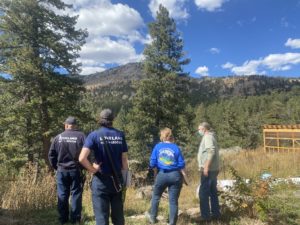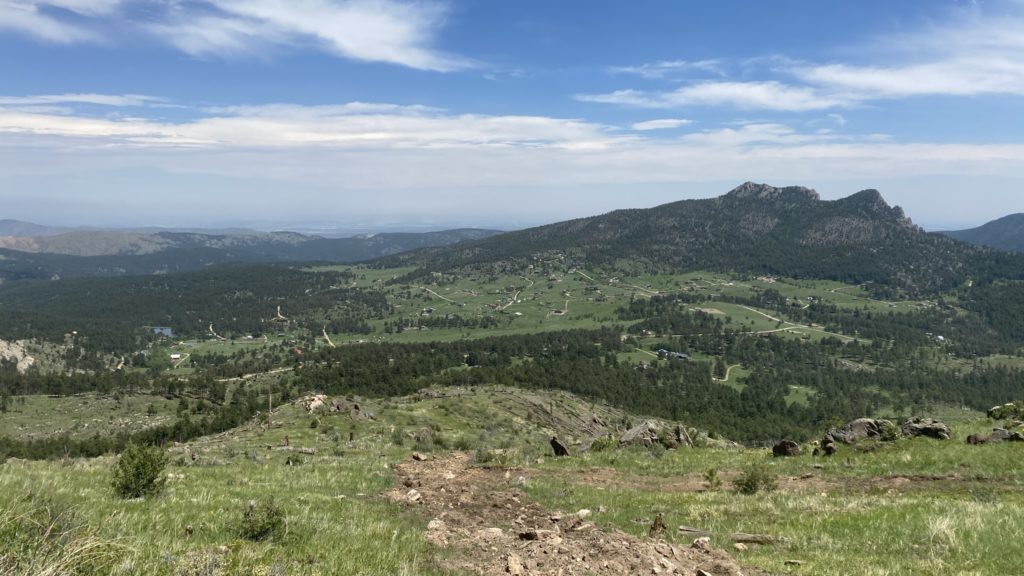Catastrophic wildfires along the front range of Colorado have been increasing in size, severity and frequency in recent years. The need to reduce the risk to people living in fire prone areas has become more important than ever as we struggle to adapt to yearlong fire seasons in a warming climate. A critical step in protecting at risk communities is working to inform landowner decision-making and increase landowner skill sets in fuel management. Our partners at the Big Thompson Watershed Coalition (BTWC) are taking bold steps and addressing this need head on in Drake Colorado.
Protecting communities against the “new norm”

Cedar Park/Storm Mountain is a densely populated mountain community in the forests of the Big Thompson Canyon. High fuel loads in the area along with a single egress route create a substantial risk to community members in the event of a severe wildfire. By reducing fuel sources on private properties, the potential for high-severity fire effects on and around these properties is decreased. Additionally, the community is surrounded by U.S. Forest Service lands which have recently been or are planned to be thinned for fuel reduction. Pairing fuel management work on private lands with larger scale forest management from the U.S. Forest Service provides greater risk reduction to the community, the forest, and the watershed.
Working collaboratively with local residents to help provide them with the tools to make decisions on lifesaving wildfire mitigation strategies is paramount. Recognizing this, the team at BTWC developed a forest management demonstration project in the Cedar Park/Storm Mountain area that promotes landowner participation in community-wide forest health and wildfire preparedness planning while implementing voluntary forest thinning and defensible space demonstration sites on private properties to reduce the risk of wildfire.
Engaged communities are empowered communities

A primary goal of the Forestry Demo Site for Decision Making Project is to engage property owners in discussions of both community-wide and parcel-specific interests and needs for forest management in order to generate community-led action to increase wildfire mitigation work. With the assistance of two graduate students from the Warner College of Natural Resources at CSU, BTWC held multiple community meetings over 2021. The purpose of these meetings was to engage community leaders (or “sparkplugs”) as well as the general community to create a foundational document to help guide the community in taking steps to reduce wildfire risk. The Wildfire Preparedness Planning document they collaboratively developed identifies fuel mitigation and emergency preparedness needs as well as existing community capacity and assets they can leverage.
In tandem with the community planning efforts, BTWC worked to circulate an application for landowners to receive forest thinning and/or defensible space assistance on their property, which would then be used as demonstration sites for other landowners to learn about these treatments. After receiving numerous applications from local landowners, BTWC selected seven properties to include in the defensible space and forest thinning implementation component of this project. Once project requirements, including the cost-share and demonstration site aspects of the project were clarified, BTWC staff and Loveland Fire Rescue and Authority staff completed in person site visits to each of the properties to identify acreage and treatment needs on the ground. In 2022, BTWC will work to complete treatments on each of the 7 properties, install educational signage about the work completed, and lead community tours of each property to highlight the work done and encourage other landowners to pursue wildfire preparedness actions on their own properties.
Communication and partnerships are key

This project could not be completed without collaborative partnerships and consistent communication. BTWC believes that community wildfire planning and preparedness efforts are most successful when they involve and engage the community as part of the solution. Furthermore, successfully implementing multi-faceted projects such as this require partnerships with other organizations who share similar goals. BTWC has been in communication with local forestry contractors, The Ember Alliance (TEA), and Larimer County Conservation Corps about their interest and ability to work on this project. The Ember Alliance will play an especially important role in this project as the entity who will burn slash piles and use a new piece of equipment called an air curtain burner to help burn other woody materials that aren’t put into slash piles. BTWC will continue to collaborate with other entities and community members throughout this project to ensure its success.
Peaks to People is very pleased to have contributed $10,000 to support this important work as part of our Big Thompson Initiative. In addition to Big Thompson Watershed Coalition, CSU and Peaks to People, project partners include Coalitions & Collaboratives (COCO), Northern Colorado Water Conservancy District, Colorado Forest Restoration Institute (CFRI), United States Forest Service and Wildlands Restoration Volunteers. More information about this project can be found in our Watershed Health Outcomes Tracker Forestry Demo Site for Decision Making in Drake, CO Project Fact Sheet.
